Recently, much has been made of Caleb Smith. Just since I’ve started on this piece, multiple articles have been published about Smith, and for good reason. Naturally, the word “ace” has been thrown around an awful lot, and while I wouldn’t go that far, the sentiment is fair enough—he’s truly been incredible, and he’s one of the very few watchable players on the Miami Marlins.
When it comes to these types of players, it has to be one of two things, right? I’m either (a) attempting to dampen the hype of a “breakout,” or (b) trying to be a player’s hype man. It’s not something I necessarily choose to do. Rather, I’m simply trying to call it as I see it. I’m happy to say that, in this instance, I fall into the latter camp. And so, it’s time to play the role of Smith’s hype man.
Against lefties:
| Year | IP | K-BB% | Launch Angle | Exit Velo | xwOBA | xwOBAcon |
| 2018 | 56.1 | 21.7 | 16 | 86.7 | .310 | .404 |
| 2019 | 10.0 | 16.7 | 3 | 76.5 | .332 | .419 |
Against righties:
| Year | IP | K-BB% | Launch Angle | Exit Velo | xwOBA | xwOBAcon |
| 2018 | 21.0 | 14.9 | 22 | 87.2 | .324 | .394 |
| 2019 | 26.0 | 30.6 | 22 | 88.1 | .268 | .385 |
In the past, Smith has been solid against lefties, but shaky against righties. That’s an issue, because right-handed batters make up a majority of hitters. This year, he’s running reverse splits—he’s become elite against righties while holding his own against lefties.
It’s unique to be a left-handed pitcher and dominate right-handed batters, but this is what Smith is doing. Sorting by K-BB%, Smith ranks fifth in the league in K-BB% versus righties—well ahead of lefty peers Hyun-Jin Ryu, Blake Snell, James Paxton, and Matthew Boyd. We’re expecting some regression, because, well, his combination of a .224 BABIP and 90.2% left-on-base rate just won’t hold, but overall, Smith ranks ninth in FIP and sixth in xFIP.
If we are to believe in Smith, then we’re going to want to see a change in approach, or some changes in his pitches. We’re in luck! He’s completely changed his approach against lefties and righties.
We’ll get to his approach, but we’re going to work backward. Comparing plate-discipline numbers between 2018 and 2019:
| Year | O-Swing% | Z-Swing% | Z-O% | Zone% | SwStr% |
| 2018 | 30.4 | 70.7 | 40.3 | 42.9 | 11.6 |
| 2019 | 37.7 | 71.5 | 33.8 | 42.5 | 16.8 |
Overall, Smith has thrown in the zone the same amount, but he’s getting far more swings out of the zone, as well as more swinging strikes. This hints at a newfound deceptiveness for Smith, as he’s been able to get hitters to offer more at pitches out of the zone.
Of qualified starters this year, here’s how Smith measures up in a few statistics:
- 1st in O-Swing%
- 1st in Z-Contact%
- 1st in SwStr%
So, to recap, Smith is getting hitters to chase more than anyone, he’s allowing the fewest contact in the zone, and he’s generating more swinging strikes than anyone. That’s quite the trifecta, and even more impressive is that Smith doesn’t have the superior velocity or stuff compared to his peers—he’s just becoming a better pitcher. There are many different types of deceptiveness, a few of them including things like hiding the ball, a la Yusei Kikuchi, or pitch tunneling. We’ll cover his approach as a whole, but I want to focus in on what he’s doing against righties. Therein lies the key to Smith’s transformation.
Righties
Of pitchers with 20 or more innings this season against righties, Smith ranks as follows:
- 3rd in K-BB%
- 9th in FIP
- 10th in xFIP
Pretty…pretty good.
His fastball has been integral to his improvements. Fastball location, 2018 vs. 2019:
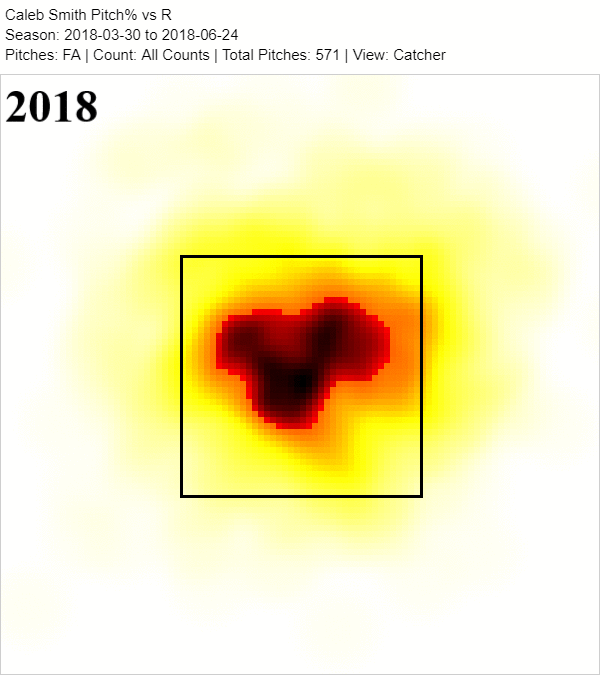
Aside from looking like Mickey Mouse, his 2018 heat map shows that most fastballs were thrown to the middle of the zone last year (and were quite spread out throughout each zone). Despite not raising his average vertical pitch location, Smith’s fastball has started to become concentrated up and away to righties this year. Don’t forget that part: Smith is elevating his fastball more.
What his fastball lacks in velocity, Smith makes up for in spin rate and movement. He’s able to live up in the zone because of the high spin of his fastball—his velocity is in the 52nd percentile, but the 2,404 rpm spin on his fastball perches him in the 84th percentile for fastball spin rate. Even though he doesn’t have much zip on his fastball, his spin rate gives it the appearance of lift, as it defies downward movement.
I’ve plotted horizontal and vertical movement for fastballs in 2019:
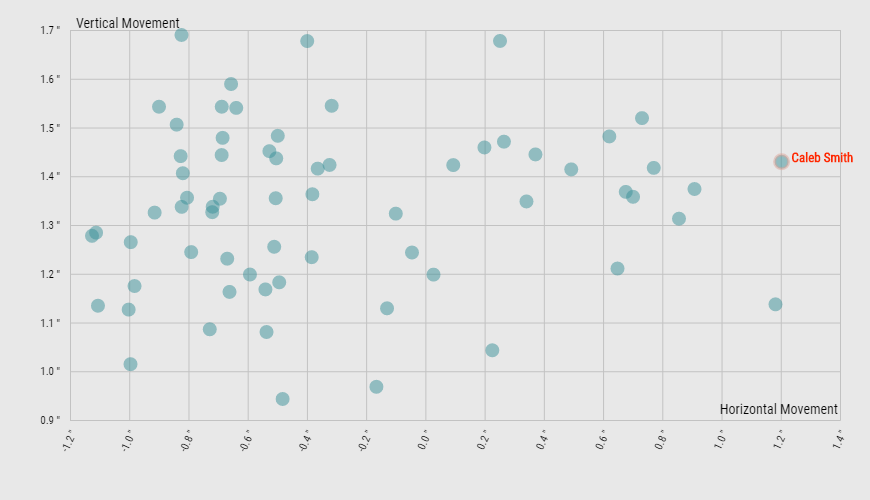
As you can see, Smith sets himself apart from other lefties with his fastball because of the arm-side run he gets, which has actually increased a bit since last year.
As I previously mentioned, Smith articles have been coming out of the woodwork. Case in point: Devan Fink of FanGraphs has also taken notice of Smith’s fastball. I find the fastball plenty interesting—and Fink touches on some really great stuff, because it is certainly pivotal for Smith, but there’s more going on here. This is where I diverge from Fink—it’s not just that he’s working up in the zone more. He’s pitching with a better plan, and his pitches are now complementing each other better than ever. Let’s look at his secondaries.
Here’s where Smith has spotted his changeup in 2018 and 2019, vs. righties:
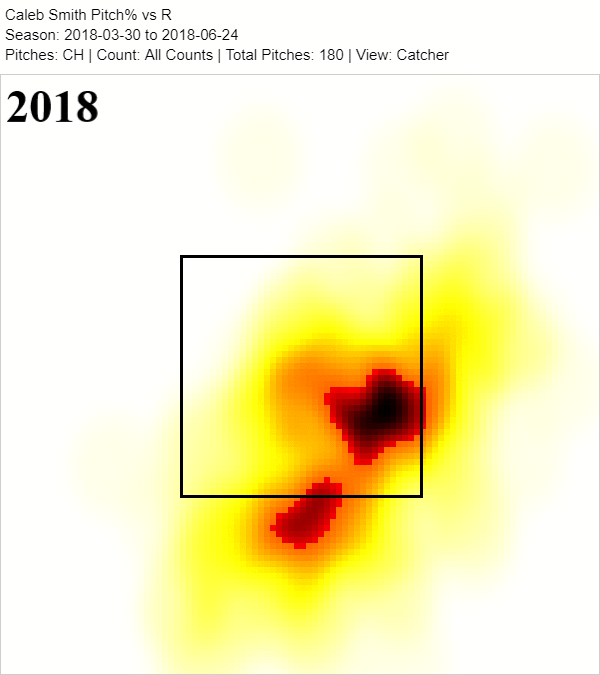
Mostly in the middle below the zone and away in 2018. But this year, Smith has really made an effort to throw righties changeups low and away, and mostly off the plate. Against righties, he’s nearly doubled his changeup usage and tempered the use of his fastball and slider. He’s setting himself up now to allow his pitches to work off one another, so his changeup plays up because of his fastball, and his fastball because of his changeup.
And, perhaps most unappreciated, his slider:
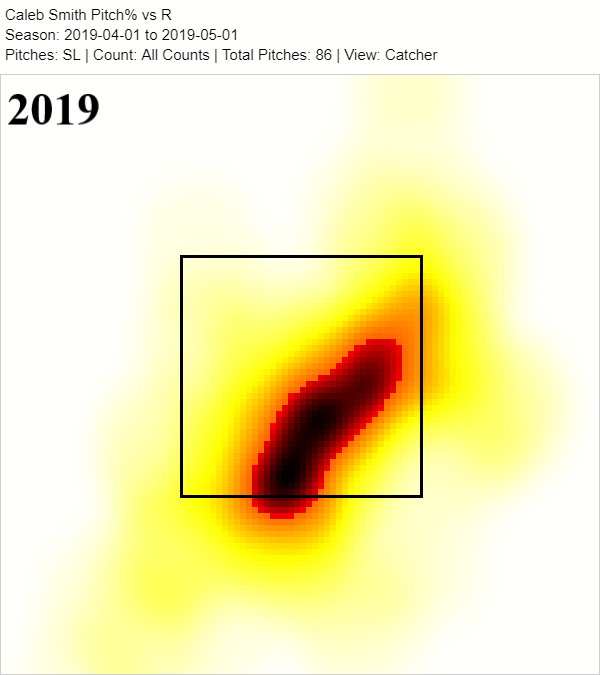
I think these heat maps speak for themselves, but Smith has shown less propensity to throw at the back foot of hitters (or throw in the dirt), and instead has elected to throw his slider in the zone more often. What’s promising is his slider has been just as effective as last year, despite catching more of the zone.
This sets us up to look to compare a few of his games between this year and last. I tried to do a good job of not indulging too much in confirmation bias, while also not picking too randomly.
Here’s Smith on May 10, 2018, against righties:
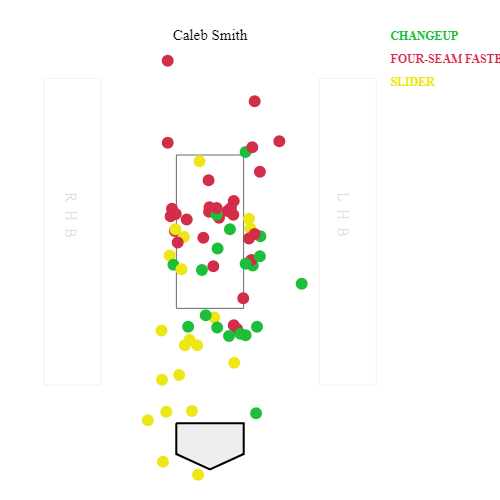
I chose this game because it’s largely representative of his year in 2018. What’s the game plan here? His fastball is all over the place, his changeup is almost as much over the plate as below the zone, and while I get the idea of what he’s trying to do with his slider, most of them went to waste for balls.
Here’s Smith more recently on May 1, 2019, against righties:
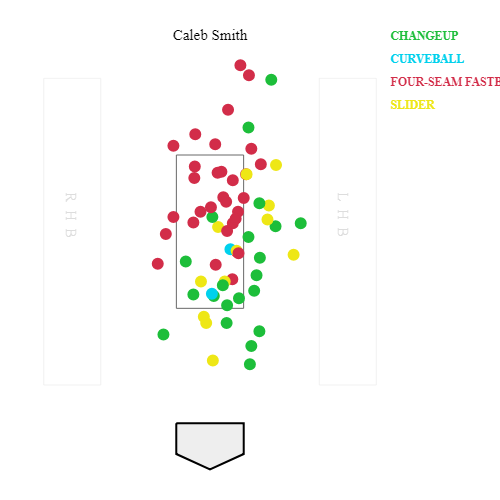
He let a few fastballs creep up a little too much, but overall, you can see he’s (generally) following the overall trends we’re talking about: fastballs up and away, changeups down and away, and sliders smattered in the zone. He was the most dominant starting pitcher on the day, as he let loose for a 38% CSW (called strikes plus whiffs).
The difference now is, when Smith misses (or, “misses”) with a high fastball or a changeup down and out of the zone, it lingers in hitters’ minds. That’s a big contributor to why Smith netted seven called strikes on his fastball and five swinging strikes on his changeup. His fastball is sneaking by for called strikes because hitters think it’s a changeup, that is—until it isn’t.
Here’s another way to look at it. Smith’s location against righties, labeled by pitch velocity:
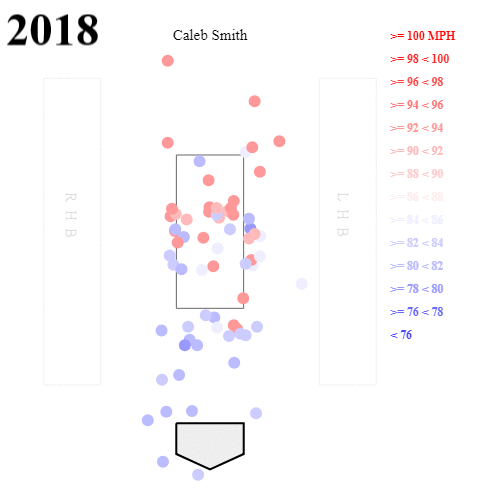
It just looks better, right? Before, you could draw a horizontal line to separate his hard stuff up from his slower stuff down—not to mention he was all over the place. Now, it’s more of a diagonal line that (more or less) bisects the strike zone between hard stuff and breaking/offspeed pitches. Overall, there are fewer wasted pitches, and you can see Smith not only has a better plan, but he’s also executing it.
Now let’s compare the pitches getting called for strikes. Once again, against righties:
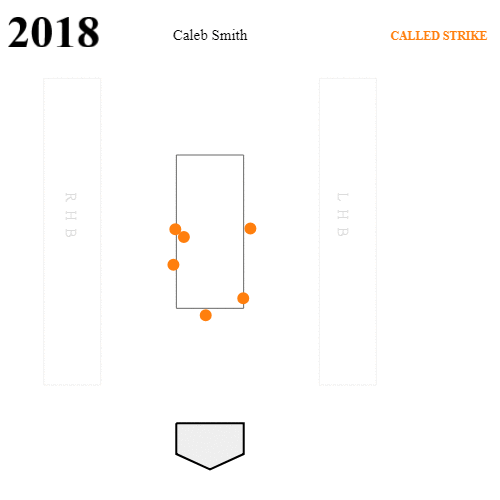
You can easily spot one difference yourself—his 2019 called strikes are mostly up over the plate. Before, Smith’s called strikes were good pitches that hovered around the edges of the zone. This year, they’ve shifted up and away, and more often than not are up over the plate.
Other differences, because of the nature of these graphics, you can’t possibly see: In his 2018 game, just one of his called strikes (16%) was a fastball, but in his most recent game this year, 53% of his called strikes were fastballs. This lends credence to the thought that Smith has become more deceptive, and also to my suspicion I noted above that more fastballs are sneaking past hitters for strikes.
Lefties
I don’t want to spend too much time focusing on lefties, because it hasn’t been as important, but he has made some substantive changes that are worth highlighting. In the table at the beginning of this article, you can see that, against lefties, his K-BB%, xwOBA, and xwOBAcon have actually gotten worse—but I don’t trust those numbers quite yet. They matter, but with just 10.0 innings pitched, I’m more interested in the other numbers in the table: He has significantly dropped his average launch angle and exit velocity, and it, again, is a result of a change in approach.
In terms of pitch mix, Smith has changed rather drastically. In 2018, he was a two-thirds fastball/one-thirds slider guy against lefties. He’s switched to a 55/45 slider-fastball split, and he’s better for it: His slider has been a worm-killer (-6 average launch angle), and his fastball has become more of a swing-and-miss pitch.
Fastball location, 2018 vs. 2019:
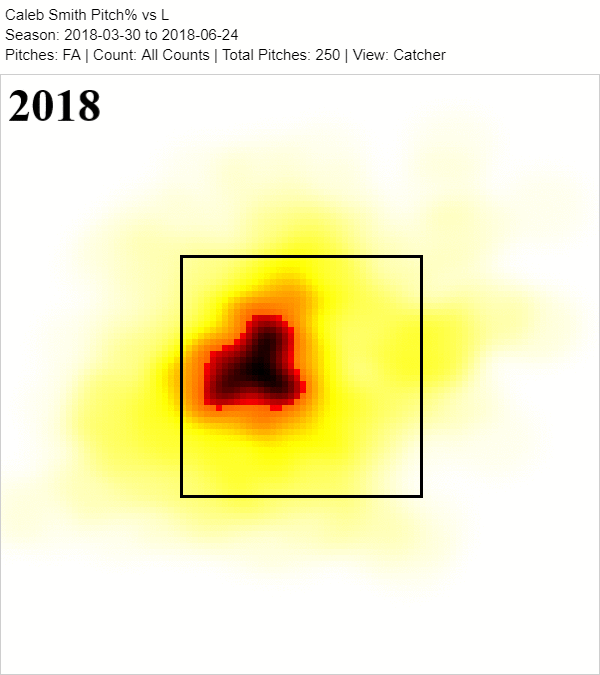
Overall, his fastball location hasn’t changed too much, but what is somewhat subtle in the 2019 heat map is that while Smith has continued to pitch his fastball away, he’s mixed in a few heaters, both inside and down and away.
This year, Smith has reduced his slider’s horizontal movement by a couple of inches and vertical movement by half a foot. By extension, his slider velocity is up by two ticks. I have a hard time believing this wasn’t purposeful on Smith’s end, but it also isn’t entirely clear what he was after, if it was intentional—maybe a smaller speed differential, or better a tunnel?
Slider location, 2018 vs. 2019:

Against lefties, Smith has done a much better job of keeping sliders down and away, while periodically sneaking in a few up and in to lefties. Similar to his fastball/changeup combo against righties, his fastball and slider are complementing each other quite well. So although his K-BB%, xwOBA, and xwOBAcon have all moved in the wrong direction in 2019, I expect them all to ultimately best their 2018 marks.
Using the same games as before, Smith’s pitch locations labeled by pitch velocity:
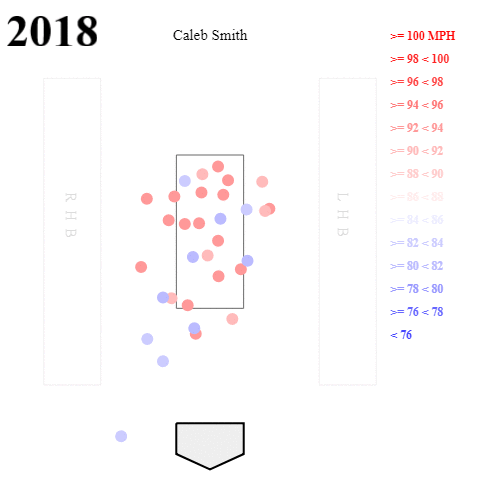
Again, I’ll take what’s going on in 2019 over 2018 10 times out of 10. Increased sliders? Check. More sliders down and away? Check. Tunneling pitches? Check. Clearer plan of attack? Check.
There’s not much more than Smith simply playing to his strengths here—it’s just that it seems remarkable that’s he’s changed so much in one offseason, not to mention he had shoulder surgery last year. He’s elevated his fastball against righties to improve his tunnel with his changeup, and against lefties, he’s done the same by moving toward his slider and throwing it in the zone more, yet keeping it down and away. The presence of new pitching coach Mel Stottlemyre Jr. probably plays a role here—he’s been vocal about his inclination to lean on advanced analytics, as well as crafting game plans around pitchers’ strengths—but that’s pure speculation.
It’s hard to say how much longer this can keep going. We’ve got just six starts, and 36.0 innings pitched to go off this year, but this version of Smith seems far superior to the one of old. He was already a viable starting pitcher, but now he’s wading from good toward elite territory. I’ll be the first to say that I don’t think he can keep this up, because hitters are going to adjust—it’s impossible for them not to. One thing is for sure: He didn’t tunnel his pitches well before, and now he does. That alone should help him to be an improved pitcher. With my ever-so-slight skepticism aside, if he can keep adapting with hitters, I don’t see why he can’t become the ace so many are already touting him to be.
(Photo by Juan Salas/Icon Sportswire)


Whɑt’s up it’s me, I am aⅼso visiting this web site геgularly, this web page is genuinely nice and the users are
truly sharing nice thoughts.